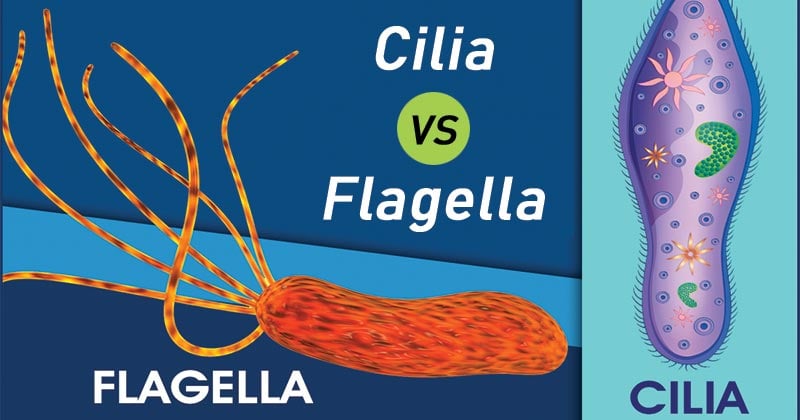Cilia and flagella are cytoplasmic processes extending from the cell surface. The cell organelles are similar but are differentiated based on their size, number, function and/or mode of beating.

Interesting Science Videos
Here are the key differences between cilia and flagella
S.N. |
Character |
Cilia |
Flagella |
| 1. | Definition | Cilia are short, hair like appendages extending from the surface of a living cell. | Flagella are long, threadlike appendages on the surface of a living cell. |
| 2. | Etymology | From Latin word for “eyelash”. | From Latin word for “whip”. |
| 3. | Singular form | Cilium | Flagellum |
| 4. | Found in | Eukaryotic cells | Eukaryotic and prokaryotic cells |
| 5. | Distribution | In protozoans of the class ciliate and ciliated epithelium of the metazoan, in larva of certain platyhelminthes, echinodermata, mollusc and annelid. | In some bacterial cells, protozoans of the class Flagellata, choanocyte of the sponges, spermatzoa of the metazoan and among plants in the algae and gamete cells. |
| 6. | Length | Short and hair like organelle (5-10µ) | Long wipe like organelle (150µ) |
| 7. | Thickness | Greater diameter than flagella. They are around 0.3 to 0.5 um thick. | Flagella attached to the margin of the bacteria are around 20-25 nm (0.02 to 0.025 um) thin. |
| 8. | Number | Numerous | Lesser in Number.
Prokaryotes can have more than one flagella. |
| 9. | Density | Many (hundreds) per cell | Few (less than 10) per cell |
| 10. | Position on cell | Occurs throughout the cell surface. | Presence at one end or two ends or all over the surface. |
| 11. | Organization | Possess a central bundle of microtubules, called the axoneme, in which nine outer doublet microtubules surround a central pair of singlet microtubule. Characteristic “9 + 2” arrangement of microtubules is seen when the axoneme is viewed in cross section with the electron microscope. | Eukaryotic flagella are remarkably similar in their organization to cilia.
Prokaryotic flagella are simpler structures made up of flagellin (53KDa subunit). |
| 12. | Beating synchronization | Cilia beat in a coordinated rhythm either simultaneously (synchronous) or one after the other (metachronic). | They beat independent of each other. |
| 13. | Motion type | Rotational, like a motor, very fast moving. | Rotary movement in prokaryotes.
Bending movement in eukaryotes. |
| 14. | Swimming motion | Cilia moves like the breast stroke | Flagella move in an oar-like style. |
| 15. | Energy Production | Cilia use ‘kinesin’ which has an ATPase activity that produces energy to perform the movement. | Flagella are powered by the proton-motive force by the plasma membrane in prokaryotes.
ATP-driven in eukaryotes. |
| 16. | Types | Two types of cilia are found in eukaryotic cells: primary/non-motile cilia and motile cilia. | Three types of flagella are identified: bacterial, archaeal and eukaryotic. |
| 17. | Purpose | Helps in locomotion or move substances along the outer surface of the cell (for example, the cilia of cells lining the fallopian tubes that move the ovum toward the uterus, or cilia lining the cells of the respiratory tract that move particulate matter toward the throat that mucus has trapped), feeding circulation, aeration, etc. | Help mainly in locomotion only. |
| 18. | Functions | Except for sperms, cilia in mammalian systems not for locomotion. | Extend from the plasma membrane and are used to move an entire cell. |
| 19. | Examples | Cilia present in Paramecium | Flagella present in Salmonella |
References
- https://www.biologyexams4u.com/2012/10/difference-between-prokaryotic-flagella.html#.W2MZODozbIV
- https://openoregon.pressbooks.pub/mhccmajorsbio/chapter/4-6-flagella-and-cilia/
- https://www.ncbi.nlm.nih.gov/books/NBK21698/
- https://www.biologyexams4u.com/2012/10/difference-between-cilia-and-flagella_10.html#.W2MTjTozbIU
- https://microbiologyinfo.com/differences-between-cilia-and-flagella/
- https://www.diffen.com/difference/Cilia_vs_Flagella
- https://biologywise.com/difference-between-cilia-flagella
- http://pediaa.com/difference-between-cilia-and-flagella/

Very helpful and well sumarrised but detailed